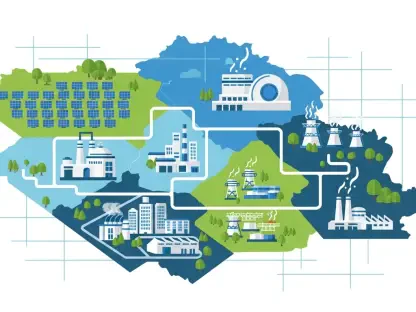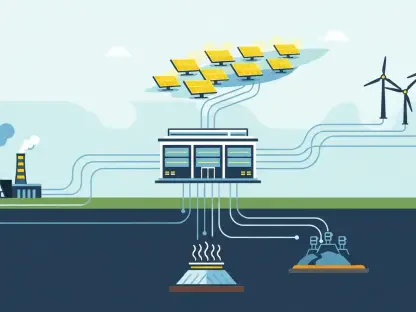In an era where technology is reshaping every facet of daily life, the electric grid faces unprecedented challenges due to the rapid integration of smart devices and renewable energy sources, transforming how energy is produced and consumed. From electric vehicles to solar panels, the proliferation of grid-connected technologies is placing immense pressure on utilities to adapt. This surge in complexity demands innovative solutions to ensure reliability and affordability for consumers. Advanced Metering Infrastructure (AMI) emerges as a pivotal tool in this modernization effort, offering utilities the ability to monitor and manage energy usage in real time. By leveraging cutting-edge technology, AMI promises to not only address current grid stresses but also pave the way for a sustainable energy future. As the landscape evolves, understanding the role of AMI becomes essential for stakeholders aiming to balance efficiency with innovation in an increasingly interconnected world.
Harnessing Technology for Grid Stability
The electric grid is undergoing a profound transformation as the adoption of distributed energy resources (DERs) like rooftop solar, battery storage, and electric vehicles accelerates at a remarkable pace. These technologies, while beneficial for reducing carbon footprints, introduce significant variability that can strain grid infrastructure if not managed effectively. Utilities face the daunting task of maintaining stability amidst fluctuating demand and supply, a challenge that could lead to costly infrastructure upgrades if left unaddressed. AMI stands out as a solution by providing real-time data on energy consumption and generation patterns. This capability allows utilities to anticipate peak loads and mitigate risks before they escalate into outages or price spikes. With the right implementation, AMI can transform potential liabilities into assets by optimizing how energy flows through the system, ensuring that both consumers and providers benefit from enhanced reliability and reduced operational costs in a rapidly changing energy environment.
Beyond immediate monitoring, AMI’s potential extends to integrating sophisticated tools like edge computing and artificial intelligence to predict and prevent disruptions. These advanced systems analyze vast amounts of data to identify patterns that signal potential failures, enabling proactive maintenance that keeps the grid running smoothly. For instance, during high-demand periods, AMI can coordinate electric vehicle charging to avoid overloading circuits, effectively turning individual devices into components of a larger, more resilient network. This level of precision not only enhances grid stability but also offers tangible savings for customers by reducing the need for expensive emergency interventions. However, achieving these outcomes requires more than just deploying technology; it demands a strategic vision that anticipates future needs and aligns investments with long-term goals. As grid complexity continues to grow, utilities must prioritize such forward-thinking approaches to fully harness the transformative power of AMI and safeguard energy delivery for years to come.
Overcoming Barriers to Implementation
Despite the clear advantages of AMI, many utilities remain hesitant to embrace its full potential, often due to a focus on short-term costs rather than long-term benefits. In regions like Michigan, where major utilities have already rolled out basic AMI to residential customers, there is a noticeable lack of commitment to upgrading to next-generation systems capable of handling the intricacies of modern energy demands. Resistance to regulatory frameworks that encourage comprehensive integration of DERs further complicates the issue, as some utilities view such measures as premature or overly burdensome. This reluctance risks rendering current investments obsolete as technology advances, potentially leading to higher expenses down the line. Addressing this challenge requires a shift in mindset, where the focus moves from immediate financial constraints to the broader value of building a grid that can adapt to emerging trends and consumer expectations over time.
Regulatory bodies play a crucial role in bridging this gap by fostering dialogue and setting clear expectations for AMI adoption. Encouraging utilities to develop detailed roadmaps that outline how AMI will support DER integration and grid resilience can prevent costly missteps. For example, state commissions could incentivize pilot programs that test innovative applications of AMI, such as virtual power plants, which aggregate DERs to provide grid support during peak times. Such initiatives not only demonstrate the practical benefits of advanced systems but also build confidence among stakeholders wary of change. Additionally, transparency in planning ensures that consumer interests remain at the forefront, balancing affordability with the need for technological progress. As the energy sector stands at a critical juncture, collaborative efforts between regulators and utilities are essential to overcome inertia and ensure that AMI serves as a cornerstone for a more efficient and sustainable grid infrastructure.
Building a Sustainable Energy Future
Reflecting on the journey of grid modernization, it’s evident that past efforts to deploy AMI laid a crucial foundation, even if initial steps were cautious and limited in scope. Utilities that took early action saw improvements in basic metering and billing accuracy, which marked significant progress at the time. However, those early implementations often fell short of addressing the broader challenges that emerged with the rise of DERs and smart technologies. Regulatory discussions, such as technical conferences held by state commissions in previous years, sparked important conversations about the need for strategic planning. These dialogues highlighted the gap between existing capabilities and the evolving demands of a dynamic energy landscape, underscoring that incremental upgrades alone were insufficient to meet future needs. The lessons learned from those early experiences emphasized the importance of aligning technology investments with a clear vision for scalability and adaptability.
Looking ahead, the path to a sustainable energy future hinges on actionable strategies that prioritize comprehensive AMI deployment. Utilities must commit to developing long-term technology roadmaps that incorporate the latest advancements in metering and communication systems, ensuring compatibility with emerging innovations. Regulators should continue to push for policies that incentivize DER integration, offering frameworks that reward utilities for enhancing grid reliability through virtual power plants and predictive analytics. Consumers, too, stand to gain from educational initiatives that explain how AMI-driven efficiencies translate to lower costs and more reliable service. By fostering collaboration across all stakeholders, the energy sector can transform the challenges of grid complexity into opportunities for innovation. The focus now should be on building momentum, ensuring that every step taken today strengthens the foundation for a resilient, cost-effective grid that meets the demands of tomorrow’s energy landscape.









